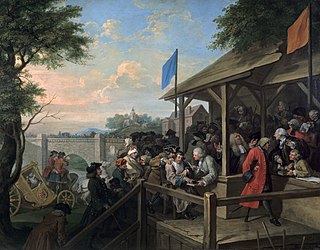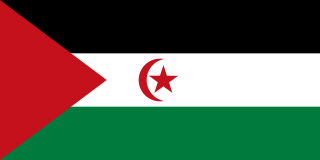
The flag of Chile consists of two equal-height horizontal bands of white and red, with a blue square the same height as the white band in the canton, which bears a white five-pointed star in the center. It was adopted on 18 October 1817. The Chilean flag is also known in Spanish as La Estrella Solitaria.

The flag of Suriname was legally adopted on 25 November 1975, upon the independence of Suriname from the Netherlands.

The national flag of Brazil is a blue disc depicting a starry sky spanned by a curved band inscribed with the national motto Ordem e Progresso, within a yellow rhombus, on a green field. It was officially adopted on 19 November 1889 –four days after the Proclamation of the Republic, to replace the flag of the Empire of Brazil. The concept was the work of Raimundo Teixeira Mendes, with the collaboration of Miguel Lemos, Manuel Pereira Reis and Décio Villares.

The national flag of Bosnia and Herzegovina contains a medium blue field with a yellow right triangle separating said field, and there are seven full five-pointed white stars and two half stars top and bottom along the hypotenuse of the triangle.

Political colours are colours used to represent a political ideology, movement or party, either officially or unofficially. They represent the intersection of colour symbolism and political symbolism. Politicians making public appearances will often identify themselves by wearing rosettes, flowers, ties or ribbons in the colour of their political party. Parties in different countries with similar ideologies sometimes use similar colours. As an example the colour red symbolises left-wing ideologies in many countries, while the colour blue is often used for conservatism, the colour yellow is most commonly associated with liberalism and right-libertarianism, and Green politics is named after the ideology's political colour. The political associations of a given colour vary from country to country, and there are exceptions to the general trends, for example red has historically been associated with Christianity, but over time gained association with leftist politics, while the United States differs from other countries in that conservatism is associated with red and liberalism with blue. Mass media has driven a standardisation of colour by political party, to simplify messaging, while historically the colour a candidate chose to identify with could have been chosen based on other factors such as family or regional variations.

The national flag of the Portuguese Republic is a rectangular bicolour with a field divided into green on the hoist, and red on the fly. The lesser version of the national coat of arms of Portugal is centered over the colour boundary at equal distance from the upper and lower edges. Its presentation was done on 1 December 1910, after the downfall of the constitutional monarchy on 5 October 1910. However, it was only on 30 June 1911, that the official decree approving this flag as the official flag was published. This new national flag for the First Portuguese Republic, was selected by a special commission whose members included Columbano Bordalo Pinheiro, João Chagas and Abel Botelho. The conjugation of the new field color, especially the use of green, was not traditional in the Portuguese national flag's composition and represented a radical republican-inspired change that broke the bond with the former monarchical flag. Since a failed republican insurrection on 31 January 1891, red and green had been established as the colours of the Portuguese Republican Party and its associated movements, whose political prominence kept growing until it reached a culmination period following the Republican revolution of 5 October 1910. In the ensuing decades, these colours were popularly propagandised, green represented the hope of the nation and the colour red represented the blood of those who died defending it, this happened to endow them with a more patriotic and dignified, therefore less political, sentiment.

The Flag of Ethiopia consists of a green, yellow, and red tricolour with the national emblem, a golden pentagram on a blue disc, superimposed at the center. While the colors green, yellow, and red in combination held symbolic importance since at least the early 17th century, the modern tricolour was first adopted on 11 October 1897 by Menelik II, and the present flag on 31 October 1996.

The flag of Maryland is the official flag of the U.S. state of Maryland and the 17th-century heraldic banner of arms of Cecil, 2nd Baron Baltimore. It consists of the arms of his father George, 1st Baron Baltimore (1579–1632), quartered with those of his grandmother, heiress of the Crossland family. The flag was officially adopted by the Maryland General Assembly in 1904.

The flag of the Tajik Soviet Socialist Republic was the red Soviet flag with white and green stripes below the gold hammer and sickle, with the measures: 1/2 red, 1/5 white, 1/10 green, 1/5 red. The flag sported the Pan-Iranian colors of red, white and green, as a nod to the republic's Persian-descended culture. The flag was adopted on March 20, 1953 by decree of the Supreme Soviet of the Tajik SSR:
The national flag of the Tajik Soviet Socialist Republic is a panel consisting of four horizontal colored stripes: the upper band of red which is half the width of the flag; white stripe, making one fifth of the width of the flag; green stripes, is one-tenth the width of the flag, and the lower band of red color, is one-fifth the width of the flag. On top of the red band at the flagpole located gold hammer and sickle and above them is a five-pointed red star framed by a gold border. The ratio of the flag's width to its length is 1: 2.The fitting of the hammer and sickle into a square whose side wound 1/4 width of the flag. The sharp end of the sickle falls in the middle of the upper side of the square, handles the sickle and hammer rest on the bottom corners of the square. hammer with a handle length is 3/4 of the diagonal of a square. The five-pointed star in a circle fits 1/8 width of the flag relating to the upper side of the square. Distance vertical axis of the star, the hammer and sickle from the grapnel is equal to 1/4 of the flag's width. The distance from the top edge of the flag of the flag to the center of the star - 1/10 of the flag's width.

The State Emblem of Uzbekistan was formally adopted on 2 July 1992 by the Government of Uzbekistan. It bears many similarities to the emblem of the former Uzbek Soviet Socialist Republic, which the Republic of Uzbekistan succeeded. Like many other post-Soviet republics whose symbols do not predate the October Revolution, the current emblem retains some components of the Soviet one. Prior to 1992, Uzbekistan had an emblem similar to all other Soviet Republics, with standard communist emblems and insignia.

The flag of the Republic of Karelia is the official state symbol of the Republic of Karelia. Adopted by the Supreme Council of the Republic of Karelia on February 16, 1993. The flag was designed by Alexander Ivanovich Kinnear.

Transnistria, a de facto state internationally-recognised as part of Moldova, has two co-official national flags. The first co-official national flag consists of three horizontal bands of red, green, and red, of vertical width 3:2:3, and in the upper canton, is the main element of the coat of arms of Transnistria; a golden hammer and sickle and a gold-bordered red star. The hammer and sickle fit into a conventional square, and the star, a conditional circle. Transnistria adopted this design that comprises a version of the flag of the Moldavian Soviet Socialist Republic used between 1952 and 1990 in the 2000 Law about State Symbols. The second co-official national flag consists of three horizontal stripes in the colors white, blue, and red, identical to the Russian flag but at a ratio of 1:2 instead of 2:3.

The national flag of Western Sahara or the flag of the Sahrawi Arab Democratic Republic uses a national flag consisting of a black, white and green horizontal tricolor charged with a red star and crescent in the center stripe and a red chevron at the hoist. It is used on SADR-controlled areas, while the Moroccan flag is used on the occupied parts of Western Sahara.

The national emblem of East Timor is one of the national symbols of East Timor.

The national flag of the People's Republic of China, also known as the Five-star Red Flag, is a Chinese red field with five golden stars charged at the canton. The design features one large star, with four smaller stars in an arc set off towards the fly. It has been the national flag of China since the foundation of the People's Republic of China on 1 October 1949. The flag was designed by Zeng Liansong.

The flag of the state of São Paulo, Brazil, serves as one of the state's symbols, along with the state's coat of arms and anthem. It was designed by the philologist and writer Júlio Ribeiro in 1888, with his brother-in-law, Amador Amaral, a graphic artist. The flag has thirteen black and white stripes and a red rectangle in the upper left corner holding a white circle enclosing an outline map of Brazil in blue. There is a yellow star in each corner of the red rectangle.

The flag of Roraima is one of the official symbols of the state of Roraima in Brazil.

The flag of Pernambuco is one of the official symbols of the Brazilian state of Pernambuco. It is a bicolor pennant, blue and white, with the colors broken horizontally into two unequal sections, with blue in the upper and larger rectangle, the rainbow composed of three colors, red, yellow and green, with a star in above and below the sun, inside the semicircle, both in yellow, and, in the lower and smaller white rectangle, a red cross.






















